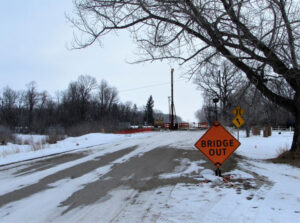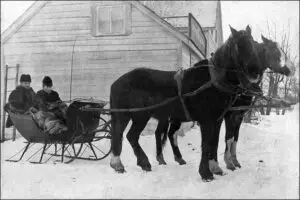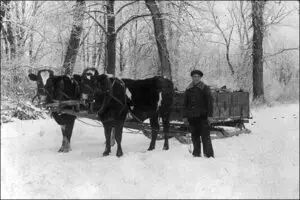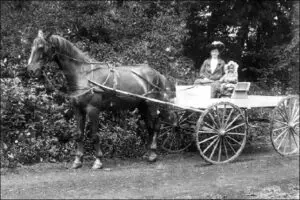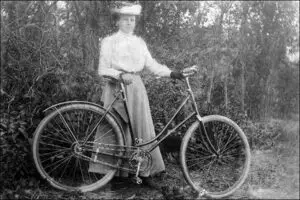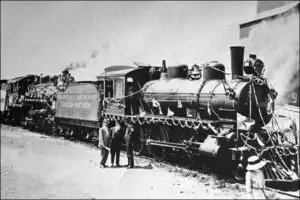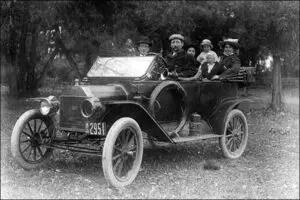March 2023
Bridge. If you are heading for Roseisle between now and July, expect a short detour from Highway 245 into the community. The concrete bridge that has provided access over the south branch of the Boyne River for the past 100 years is being replaced by a wider two-lane structure.
The bridge that is being replaced is one of several featured in Gordon Goldsborough’s Manitoba History article on bridges in Manitoba and on the MHS website In these articles, the author notes that the “concrete beam bridge was built in 1923 by the contracting firm of J. C. Badger & Sons, using Plan 1000, for $7,782.” His photos from 2013 illustrate the post and beam structure found in this and other bridges in the area. Note the rough upper surface of the railings which suggest that some part of the structure is missing.
We don’t have records of an earlier bridge at this location and, so far, the search for early photos of the 1923 structure have hit the proverbial brick wall. It seems, unfortunately, that this was one of the years the local newspaper didn’t have the usual newsy input from a Roseisle correspondent. But, as often happens, this is where oral histories come to the rescue.
An early resident recalled that the bridge originally had higher railings with concrete balusters. When a large three-story house was being moved out of town, he had watched the movers jack the house up high enough to clear the railing. From his description, it seems likely that the bridge was similar to the concrete beam bridge no. 929 over the Boyne River between Graysville and Stephenfield. Boyne River Bridge So what happened to scale it down to the present height? The same interview throws light on the subject.
Our informant chuckled as he recalled what happened:
This bridge – do you remember when it was higher – had those pillars on it? [Name deleted] was going to blast some fish out of there with dynamite. He put a stick of dynamite in a tobacco tin – he thought it would sink – but it didn’t sink, and just at the time it blew, it was underneath the bridge – and it loosened all those big pillars. They had reinforced steel in them too. It loosened every one of them.
It’s too bad we don’t have other records of the local reaction to an event that must have shaken the small community. Or maybe our image of a quiet little hamlet guided by three local churches isn’t quite spot on. The above interview continued as follows:
He [the ‘fisherman’] was a wild guy. One Halloween he and [another local lad] put half a stick of dynamite under a cream can on the station platform and that cream can went up in the air higher than the elevator.
So maybe the bridge story wasn’t even newsworthy?
The new bridge is scheduled for re-opening by July – hopefully in time for the July 1st celebration that is the highlight of the year in Roseisle. At present, the huge piles are being driven in place and the construction crew report that work is ahead of schedule. The new bridge will be wide enough for two cars to pass. This is not the case at present where one vehicle now has to pull up and wait.
Meanwhile, this story serves as a reminder that you can learn a lot from the recorded facts and events of history but the memories and stories behind the event are often a lot more fun. If you happen to know of any early photos of the Roseisle bridge, we’d be delighted to see them. Incidentally, have you begun yet to record your own life story?
Prior to 1900 and for the first decade or so of the 20th century, horses were the main source of
transportation in the rural Carman/Dufferin area. Arrival of the railway in Carman in 1901 and its extension westward over the next two years, opened the area to outside travel and to easier shipping and receiving of goods. From 1906 to 1926, another rail line connected Carman with Portage la Prairie and the U.S. border. Soon the automobile replaced the horse and buggy, beginning an emphasis on maintaining roads and bridges that persists to this day. Unless otherwise indicated, photos are from the collection of early Roseisle photographer J.B. Coleman.
Railways
Rail lines were the lifelines of new settlements, connecting them with larger centres, bringing in mail and supplies and transporting grain and livestock to market. Communities lobbied and offered bonuses to competing rail companies. In 1882, the Manitoba Southwestern Colonization Railway (later the Canadian Pacific Railway) was built southwest from Winnipeg. Unfortunately, it stopped short of Carman at End-of-Line (Barnsley) until 1887 when the CPR extended the line the final six miles to Carman.
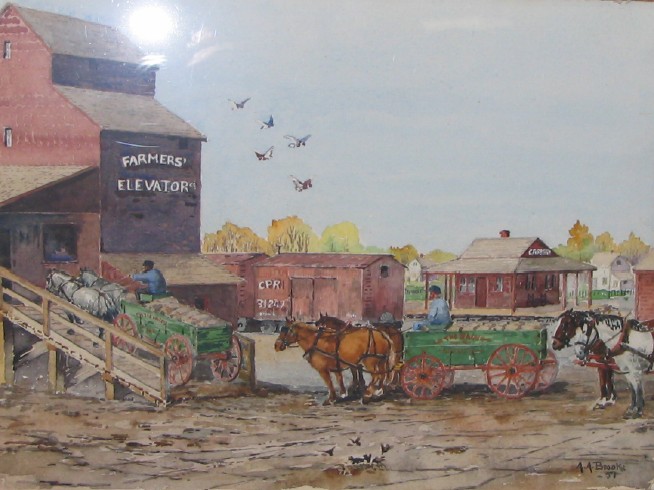
A.A. Brooke painting of farmers bringing grain to local elevators early 1900s
From 1906 to 1926, the Midland Railway ran from Portage-la-Prairie to Carman and south to the US border. And in 1901, the Canadian Northern (later the CNR) reached Carman from the east, continuing westward through the escarpment. Small villages grew up along the railway as existing schools, churches, stores and post offices relocated beside the rail lines. Railways, with their stations, elevators and loading platforms, opened access to new markets and allowed farmers to ship their grain to the East and around the globe.

